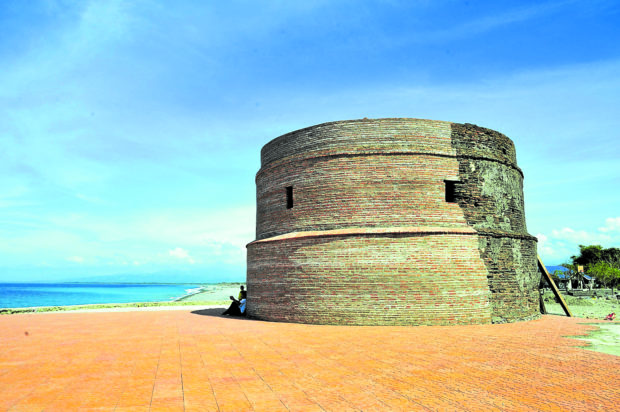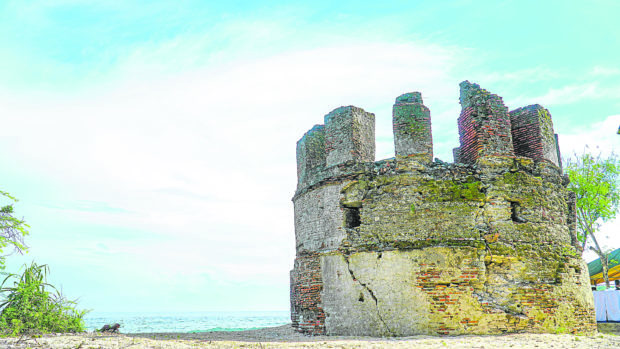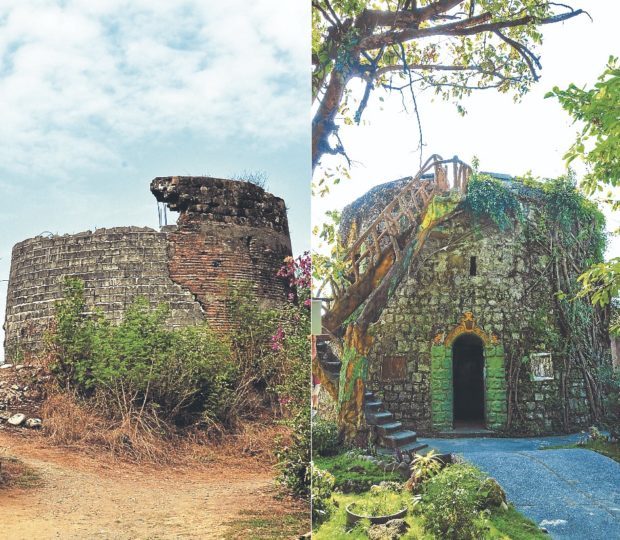La Union watchtowers battle neglect, modernity

LUNA LANDMARK The Baluarte in Luna town’s stone beach used to be the most recognizable watchtower in La Union province due to its distinctive appearance, as if it was sliced in the middle. A storm destroyed
the leaning half of the structure, prompting the local government, through funding assistance from the National Museum, to rebuild it in 2017. —PHOTOS COURTESY OF LA UNION PROVINCIAL INFORMATION OFFICE
SAN FERNANDO CITY, La Union, Philippines — The towering structures that used to dot the Ilocos region’s coastline once served as fortification outposts that allowed Spaniards to watch for approaching pirates in the 1600s.
According to stories passed on by elderly residents in La Union province, a sentry manning a watchtower would peer into the wide expanse of the sea to catch the sight of a suspicious-looking seacraft moving toward the shore. With an impending danger, the anxious sentry would raise the alarm. Church bells would then ring to signal the imminent arrival of marauders engaged in slave trading.
In turn, residents would frantically seek shelter behind the thick walls and barred doors of the town church.
In that era when the Philippines was a colony of Spain, these structures were the first line of defense and “symbols of security to the townspeople who were vulnerable to the marauding, predatory pirates,” said former San Fernando City Mayor Mary Jane Ortega, citing various historical accounts.
These watchtowers were mostly made of coral blocks held together by lime and egg whites, according to Ortega, a staunch advocate for the preservation of the centuries-old watchtowers in the province.
Article continues after this advertisementIntruders
Ortega said it was in 1572 when the Spaniards started colonizing the Ilocos, and the following years saw the construction of massive churches in northern Luzon.
Article continues after this advertisementBut every summer, Moro pirates would raid coastal communities and take village women, so the Spaniards put up watchtowers to warn communities of these intruders.
The towers could also have been fortresses against foreign invaders who posed threats to settlements overseen by Spanish administrators. Among these “enemies” were Chinese merchant-pirate Limahong, who tried to establish a base in northern Luzon in 1574; the Dutch, who tried to take the Philippines away from Spain between 1600 and 1604; and the British, who occupied Manila from 1762 to 1764.
Several centuries later, the watchtowers have outlived their purpose, although some of them still stand and are trying to battle neglect, the elements and modernity around them, Ortega said.
“They are in different states of disrepair and look like ghosts of their grand architectural designs,” she said.
The five watchtowers in the province are found in the towns of Luna, Balaoan, Bacnotan, San Juan and in the capital city of San Fernando.
All have been declared by the National Museum of the Philippines (NMP) as cultural treasures in 2014, but only those in Balaoan (Almeida watchtower) and Luna (Baluarte) have the NMP markers.

INTACT The Almeida watchtower in Balaoan town is the best preserved among these ancient coastal structures in La Union.
Preservation
Local governments are racing against time to preserve these historical treasures but, except for Luna, have to contend with issues like private ownership of properties where the remnants of the watchtowers are located.
Two are “missing” in San Fernando City, said Randal Brioso, the city’s cultural mapper. One was at the former Wallace Air Station and another at the ruins of the Pindangan Church.
“We want to find even just the watchtowers’ bases or foundations so we can include them in our map of historical sites,” he said.
Brioso said a Carmelite pamphlet cited an account of one Mr. Umel, who lived near the Pindangan ruins, playing at the base of the watchtower beside an acacia tree. The foundation or any part of the structure had not been found.
As for the missing one at the Wallace Air Station (now Poro Point Freeport Zone), only an old photo of the watchtower is proof of its existence, Brioso said.
Seawall
The still existing structure is in the village of Carlatan in this city, whose old name was Pindangan (meaning “where fish are dried”) during the Spanish era.
The structure used to be about 2 meters higher, Ortega said, citing various research on the original designs.
Through the years, the sea swelled and the waterline reached the tower’s base, prompting the land owner, Esperanza Rillera, to construct a seawall and to protect the area with a 2-m-high concrete barrier.
Rillera and her late husband acquired the land in 1964, describing it as a “jungle” and the watchtower as “just a hollow structure with no stairs.”
The watchtower, which survived bombs dropped by both the Americans and Japanese during World War II, was left untouched for many years.
In the 1970s, the Rilleras put up Car-Rille, a function area for weddings and other parties. Finally, the couple found a use for the “hollow structure” and built a “honeymoon suite” inside it for their newly wed clients.
A concrete stairway outside the tower and a bedroom with a bathroom in the middle of the structure were built. The tower’s top was converted into another space, equipped with a washroom, to offer guests a sweeping vista of the sea.
But the honeymoon suite and the washrooms were knocked down when the beams were eaten up by termites later.
Rillera has donated the watchtower to the city government. Brioso said negotiations are ongoing between Rillera and the city government for the watchtower site’s donation.

COASTAL DEFENSE Remnants of Spanish-era watchtowers can still be seen in the surfing town of San Juan (left) and in the village of Carlatan in the capital San Fernando City. These structures were important in warning La Union’s coastal communities of pirate raids when the Philippines was a colony of Spain.
Property issue
Like the Carlatan watchtower, the one in Bacnotan is also in a gated private property in the boundary of Bulala and Poblacion villages, said Cheresa Lamtocon, the town’s tourism officer.
The owners are still “hesitant” to donate the structure to the local government for historical and preservation purposes, she added.
The watchtower lays forlorn with some walls already eroded by earthquakes that also raised sections of the floor. Portions of the wall are held by roots of trees that have penetrated the structure.
“It is badly damaged but can still be restored as its fragments are still there,” Lamtocon said.
She asked locals if they knew of stories about the watchtower. “Sadly, no one knows,” she said, adding that even the local government learned of the structure’s historical significance only in recent years.
Like the other watchtowers, the structure in Ili Sur in the surfing town of San Juan is in a state of disrepair due to storm surges.
“About a third of the wall, the one facing the sea, had collapsed and was temporarily replaced with other materials. There is a brace around which has been there since 2016. Since then, it has not been touched,” La Union tourism officer Exekiel Lanuzo said.
Funding sought
The local government plans to ask the national government for funding to restore and preserve this piece of history in their midst, he said.
But the local government could not go full blast on the rehabilitation plans because the structure is inside a private lot. “The issue of ownership needs to be settled first,” Lanuza noted.
In Balaoan, the NMP marker for the declaration of the Almeida watchtower as a national cultural heritage was unveiled on June 25, seven years after it was declared as such.
This structure appears to be the most intact among La Union’s ancient watchtowers, but the bricks used as an outer wall cover have been damaged, exposing the coral stones.
“It still needs rehabilitation,” said Mae Oblero, Balaoan’s tourism officer.
The Baluarte in Luna, nestled in a scenic stone beach in Victoria village, is the most popular among the watchtowers in the province.
A strong typhoon in 1996 broke the structure in half, as if it was sliced in the middle. The damage was worsened by human activities like pebble picking and magnetite (black sand) mining in the area.
In 2014, it was declared by the NMP a national treasure but a year later, another typhoon whipped storm surges that collapsed the tower’s leaning portion.
The Baluarte’s restoration was completed in 2017 through a P10-million funding assistance from the NMP.